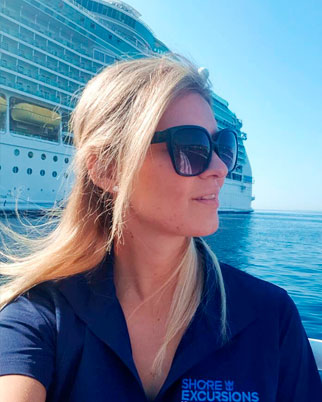Who Can Become a Travel Blogger?
If you look at existing travel bloggers, you will find a variety of people among them, including solo travelers, married couples with children, retired people, young people, and even children.
There is no single portrait of exactly what a travel blogger looks like, but there are a number of personal characteristics that are desirable to have in order to become a successful travel blogger.
Love to Travel
It is hard to find a person who does not like to travel. If you don’t like traveling, then you are unlikely to become a successful travel blogger. However, since you are already looking for guides on how to become a travel blogger, most likely you already have a love for this topic.
While blogging, you have to share your experiences, inspire people to travel, and delve into the details. Therefore, for a successful start, it is important that you love to travel as well.
Technical Skills
Starting a travel blog is not rocket science. Below, you will find a detailed plan to become a blogger. If you’re able to work with any apps, such as Microsoft Word, then you’ll be able to get to grips with the intricacies of blogging on a technical level as well.
Complex technical solutions, such as automated emails for your subscribers, can always be entrusted to specialists; however, to start and run a blog, you probably will not need to hire anyone.
Clarity
Blogging is about content, you have to share information with your audience. This can be in any format, such as text, photos, or even a video or podcast.
It will be great if you know how to correctly and clearly express your thoughts in any format. If not, no problem. Among bloggers, there are few real journalists, but there are many ordinary people who blog in their own styles and communicate with the audience in their own ways. Clarity is the most important factor for making your audience comfortable with your content. Moreover, writing skills can always be improved, especially since there are many courses, such as:
Persistent
Being persistent and achieving what you set out to do is an important quality in any endeavor, including blogging. Although, with our step-by-step guide on how to become a travel blogger and earn money from blogging, you can go faster than if you started from scratch. You need to be willing to work and be persistent.
Many bloggers do not receive income for their work at first and, only with an increase in traffic, do they start earning. With that said, some of them earn even five figures per month.
Step-By-Step Free Guide on How to Become a Travel Blogger and Get Paid
You can become a travel blogger in less than a day. However, launching a travel blog is only the beginning. There is plenty of work to develop a blog and generate a high income. Below, you will find a free, step-by-step guide on how to start a travel blog and get paid.
1. Choose the Format of Your Future Blog
You need a platform on which you will share content and attract your audience. This could be:
- A standalone travel blog website, such as travelbybrit.com, theworldtravelguy.com, okeventures.com, etc.
- Blogs on various blogging platforms, such as Medium.com
- A social media account
- A YouTube channel
Posting on someone else’s website, such as Medium, may sound simpler than the other options; however, there are big risks and limitations. Since you do not control the third-party website, you would have limited opportunities in terms of earnings (most often, you cannot embed ads).
Social media platforms are a great addition to standalone travel blogs. However, establishing a YouTube channel is usually a time-consuming project that requires a different approach.
The first option (your own website) is the most popular for starting a blog. Thus, we will examine the process of becoming a travel blogger based on this approach. With that said, even this option has various approaches. You basically have two options for launching a website:
- Create a website on a free platform, such as Blogpost
- Create a standalone website on your own domain, such as travelblog.com
The first option is temporary for most bloggers (it is almost impossible to find a successful blog that kept their website on free platforms), since such solutions significantly limit one’s technical capabilities and earning opportunities.
Creating a standalone website is the correct strategic approach. You will be in control of the site, so you would be able to choose the way you post content, the way you earn on your travel blog, etc.
2. Website Creation
To launch a travel blog you will need:
- Domain – the name by which you can be found on the Internet
- Hosting – a computer on which your site will be located, from where it will be accessible to users around the world
- Content management system – the technical part of your blog, which will make it possible to manage your site
- Website design – how your website will look
Let’s explore each point in more detail.
Domain
You need to find a free domain (spoiler: most words are taken, so you likely will need to invent your own name to find an available domain) and buy it. Usually, a domain can be purchased for a one-year period, and then each year, you will extend your registration. All this can be done at any of the following sites:
- GoDaddy
- Bluehost
- Name.com
- And many others (just use Google to find the most suitable option for you)
There is one most popular domain zone (.com) and many others, such as .net, .info, or even .travel and .blog. In the .com zone, it is difficult to find an available name. In the others, it is a bit easier. However, in pursuit of a beautiful name, check the popular domain zone anyway so that you don’t run into problems in the future.
Cost: $10-15 per year for the domain in the .com zone and 0-200$ for most other domain zones.
Hosting
Many domain registrars offer to buy hosting right away. This is a good solution, but there are many hosting companies. Thus, you can buy a domain and hosting in different places. Here is a short list of some hosting providers:
- Bluehost
- A2Hosting.com
- Scalahosting.com
Most hosting providers allow you to upgrade your plan in the future. During, in the beginning, the initial fees will be enough for you and you should not buy an expensive plan. In the future, when you have a lot of traffic on your travel blog, you can expand your hosting.
Cost: $50-100 per year
Content Management System
A content management system (CMS) is a program on the server. For you, it is more like a visual interface, like Microsoft Word, in which you can interact with your travel blog as an administrator. You can learn more about CMSs in this video:
The most popular travel blog management system is WordPress. If you do not have specific requirements, then don’t even bother looking at the alternatives and immediately select this option.
Some hosting companies are able to install the CMS for you, but you can definitely do it yourself. Here is the official manual.
WordPress is so popular and suits many travel bloggers, as its functions can be extended. For example, to install an SSL certificate, you can use a special plugin, as well as work with photos, SEO, etc.
Cost: from $0
Design
After installing WordPress on your hosting platform, your travel blog will already be available to users, but it will look like this:
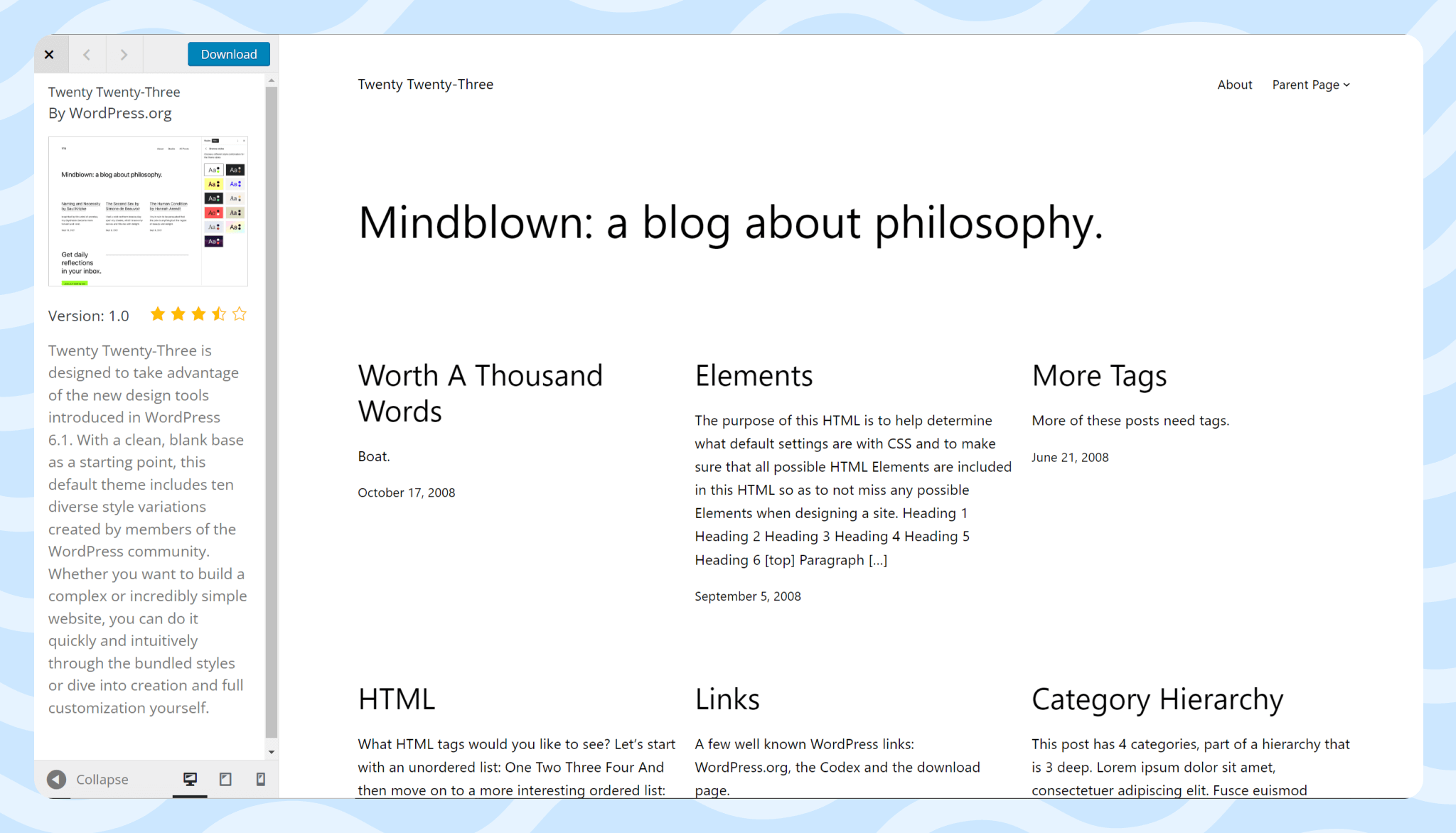
This is a free standard template that all WordPress blogs are starting. However, there are dozens of free pre-made designs. All you have to do is install them from your blog’s admin panel:
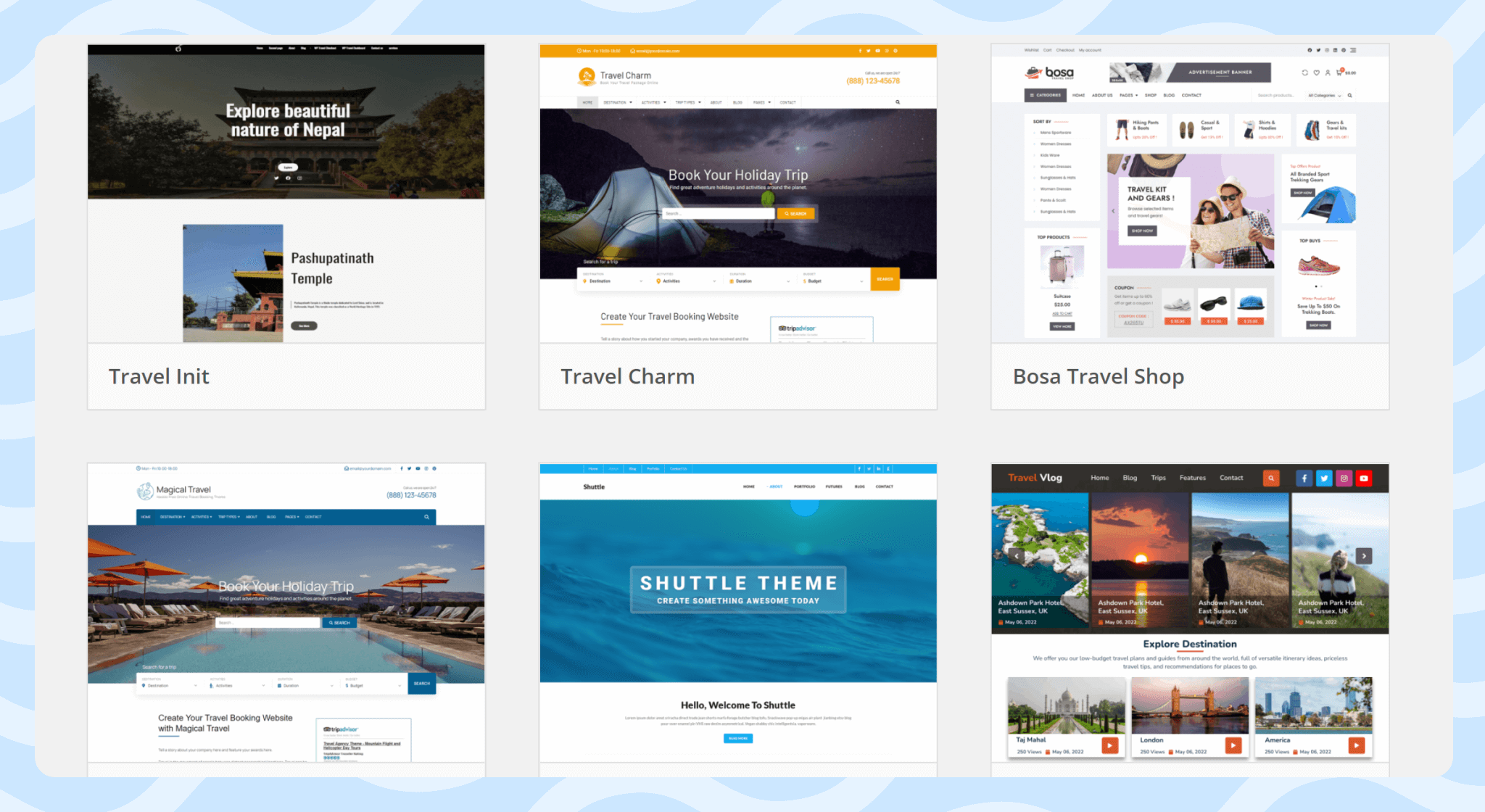
There are also many paid professional ready-made designs that you can buy (for example, on ThemeForest).
You don’t have to invest in a paid design and logo right away, as your design doesn’t have that much of an impact at the initial stage. Thus, you can start a blog with zero costs and upgrade it in the future.
Cost: from $0
3. Content Creation
If you’ve already reached this step, we congratulate you! Your blog is live and available to your audience! The first two stages were preparatory. Now, the constant work of creating content for your blog begins.
You need to prepare your first piece of content. To do this, explore topics that you think will be interesting to your audience. Creating a table of contents, writing an article, checking it for plagiarism, and more come after. The number one step is determining what your future audience will be searching for.
If you focus only on your own interests, you risk having low organic traffic. It is important to write about what is interesting to you and your audience at the same time. You can literally check how many people are looking for this or that search query and prepare material for it. How to do this is discussed in more detail in the free Travelpayouts course from the eminent travel blogger Sharon Gourlay.
When preparing your content, try to provide the most complete and detailed responses to user requests. Also, demonstrate your expertise. Even in the initial stages, this will help you gain the trust of the search engines that will generate traffic for you.
Google and other search engines will, in most cases, be your main sources of traffic, so it will be very useful to take their requirements into account when creating content. You can learn more in various courses, such as:
- Best of SEO: #1 SEO Training & Content Marketing Course
- Content Writing & Copy Writing For SEO and Sales
- SEO Course
You can also attract additional traffic to your website from social networks. To do this, you have to first create social networks, and then publish posts about new articles on your blog.
Content creation is indeed a lengthy process. You may not have much per article at the very beginning, but for good traffic volume, you will probably need a lot of articles that can drive a decent amount of traffic.
To speed up the process, you can also hire authors (spending about $0.10 per word on average). However, hiring someone to write for your blog is most common in the later stages, once you have already figured out what kind of content you need to create.
4. Travel
Google is potentially your main source of traffic, and Google in 2025 values expert content. To prepare such content for your blog, you have to travel and dive into your topics.
There are bloggers who prepare posts based on someone else’s content. Such articles are difficult to make more useful than existing content and, therefore, are more difficult to promote on Google. In addition, you will also have problems with photos, since you cannot take someone else’s photos without permission or you will have to buy them on sites like Shutterstock. Therefore, traveling for yourself is an integral part of running most travel blogs.
You do not have to go to the other side of the country or even leave your hometown (unless you want to). Study the demand of the audience in your city or nearby locations. It is likely that you can create content about something near you. For example, if you live in Virginia, you can create content about your surroundings (for example, Virginia’s national parks are in huge demand):
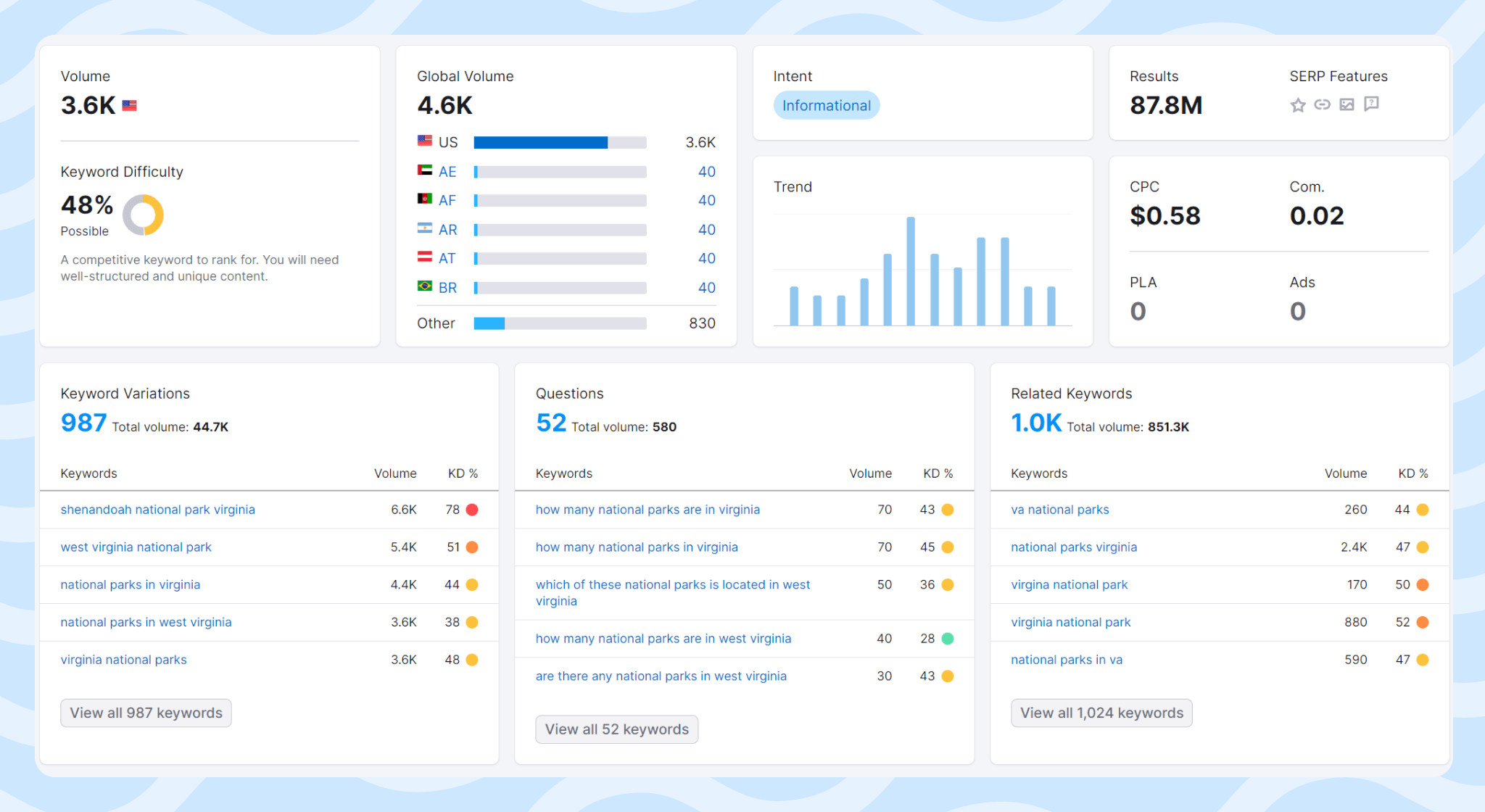
An alternative to travelling for yourself could be hiring copywriters and travelers who will share their stories on your pages, but this, as we noted earlier, is a different approach and requires investment.
How to Get Paid As a Travel Blogger?
Being a travel blogger is not only fun and beneficial to the travel community, it is also a source of solid income. It’s a paid hobby! That’s great, isn’t it? Not all travel bloggers earn five figures monthly, but you can easily get $1,000 to $2,000 a month in a short time after starting your blog. Below, you will find the most popular ways to get paid as a travel blogger.
Affiliate Marketing
To get traffic from search engines, your content must be useful to your audience. Affiliate marketing can make it even more useful, while earning you more money. It works like this:
- You recommend a service from a specific brand in your articles, such as a hotel on Booking.com or a tour on GetYourGuide.
- Your audience buys services based on your recommendation (clicking links in your article to proceed to the specific travel brands’ websites).
- You receive a commission for the sale. Brands share their income with you as thanks for recommending travelers to book a service on their platform.
The travel services price for your audience is exactly the same as without your recommendation. So, they are not overpaying or losing anything, just getting good recommendations. Brands will be more willing to share sales revenue if they see your channel is a great source of customers for them.
You can earn up to 40% of the cost of services from affiliate marketing, but usually, brands share up to 10%. Here are some examples:
| Brand | Category | Commission |
| Viator | Tours & Activities | 10% |
| Rentalcars.com | Car and Bike rentals | 6% |
| Flixbus | Trains and buses | 5% |
| i’way | Transfers and Airport Services | 7% |
| WayAway | Flights | 50% (Revenue share) |
All of the listed brands and dozens of others are available on the Travelpayouts Partnership Platform. More than 350,000 successful travel bloggers have already joined the platform and you also can join as well to access links that allow you to recommend the services of your audio room:
Join the Travelpayouts partnership platform
Join todayYou can connect your travel blog to travel affiliate programs literally from the first day of your website’s existence. Some brands accept only blogs with traffic, but there are many that work without moderation. Nevertheless, traffic on your site is important for earning money.
Since you will be earning revenue from sales, that revenue will start coming in once your articles have traffic. However, you can also place affiliate tools right away, so that, in the future, you don’t have to return to integrate links into existing articles.
Affiliate marketing is one of the most popular options for those who want to become travel bloggers and make money. To figure out how to become a successful travel blogger and make money with Travelpayouts, join a free course.
Contextual Advertising
In addition to earning on the recommendations of travel services to your audience, you can earn on advertising by completing the following steps:
- Join an advertising network, such as Ezoic or Google Ads
- Place the ad code on your website
- The ad network shows ads inside your articles
- When your audience clicks on an ad, you earn per-click revenue
This method is not related to the sale of services and goods. It doesn’t matter if the person who clicked on the ad ended up buying what was offered to him/her. Since the advertiser risks much more in this case than in affiliate marketing (where you receive income for sales), the income per click is much lower. Moreover, many modern ad blockers (such as Ad Blocker Plugins for Google Chrome) prevent such ads from displaying.
Some travel bloggers can combine this method with affiliate marketing to earn even more. For example, by placing contextual advertising on pages where you do not offer (and could not offer) any services directly from brands for a commission.
Freelancing
If you are an active traveler, then you can make money as an author. Having your own travel blog will be a great portfolio and you can even make some decent money by writing for someone else.
You can place an offer on your blog that you are open to creating content, as well as participating in specialized copywriting groups on Facebook. You can also offer your services on Fiverr, Upwork, or other freelancing platforms.
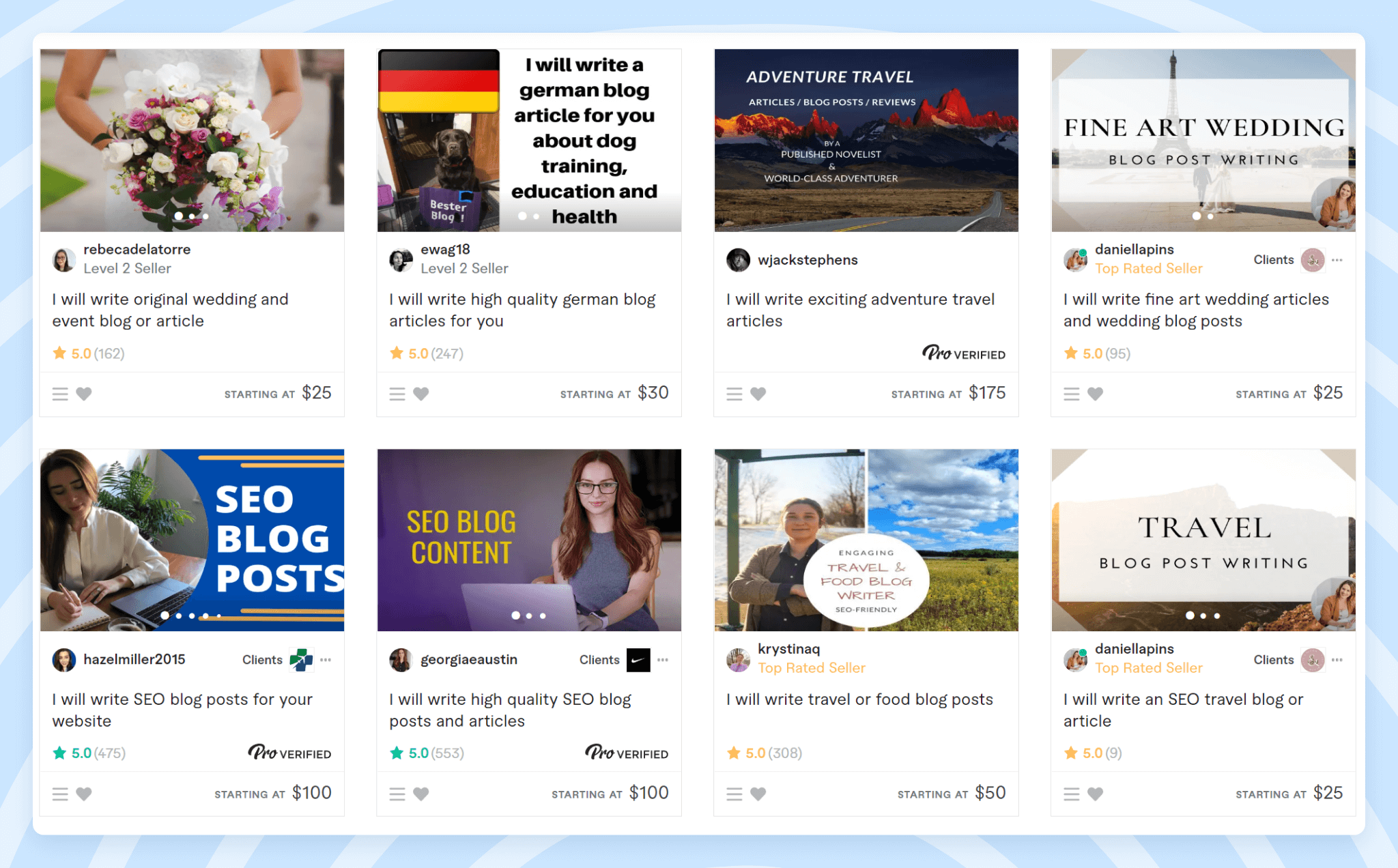
On average, you can earn about $0.10 per word in English.
Guest Posting
Your travel blog is interesting to other site owners in terms of SEO. In some cases, people may be willing to buy links on your site, especially if your blog has a high DA rating.
The guest post or link price depends on the authority of your blog as well as how many external links it already has. A regular blog may earn a few hundred dollars per link, while a more reputable and popular blog can earn over $1,000 per link.
This is an attractive method, but unlike affiliate marketing and advertising, it is a one-time thing. In addition, you need to create new content for new links (usually people are not ready to buy from posts that already have a link, and previous buyers will not think it is fair if you sell an extra link next to theirs).
In addition, selling links can negatively affect your organic traffic, as paid placements are sometimes viewed negatively by Google. This is often considered a manipulation of the rules of the search engine. Therefore, you should not abuse this method to earn money, and perhaps you should not use this method at all.
Is It Possible to Become a Travel Blogger and Live Off the Income From Your Blog?
Becoming a travel blogger is not as difficult as becoming a successful travel blogger who earns money from blogging. However, there is a lot of evidence that this goal is quite possible to achieve. Here are the stories of just a few bloggers:
- Travelbybrit.com
- Theworldtravelguy.com
- TheLithuanianAbroad.com
- Oceanwideexplorers.com
- Twooutliers.com
Among successful bloggers, there are completely different people, many of whom started in the 2020s. This debunks the myth that it was necessary to start earlier. The only correct answer is that, if you start now, you can also become a travel blogger and earn money through Travelpayouts and other means.
Even though there is a lot of work to put in, and reaching five figures per month can take a long time if you are a newbie, traveling the world and making money on it is definitely possible.
FAQ
Although the idea of becoming a travel blogger is very attractive to most people, even after our step-by-step guide, you may still have questions. So, we answered some the most common questions here.
How much money do I need to start?
You can start a travel blog for $0. Above, we mentioned some costs, but you can start for free. For example, social media platforms are excellent places to share and earn money on your travel experiences. You can also start a blog on your own domain for less than $100.
Even though successful travel bloggers usually travel a lot to create new content, you can start where you are now. This is the first location that you can speak about as an expert. By creating content yourself, you will not have to deal with the additional costs of hiring authors.
Is it necessary to travel to become a successful travel blogger?
Each person lives in their own area and you can become an expert of this location. Of course, the potential of various places is different. You can study the tourist demand before starting a blog, including through Google Trends.
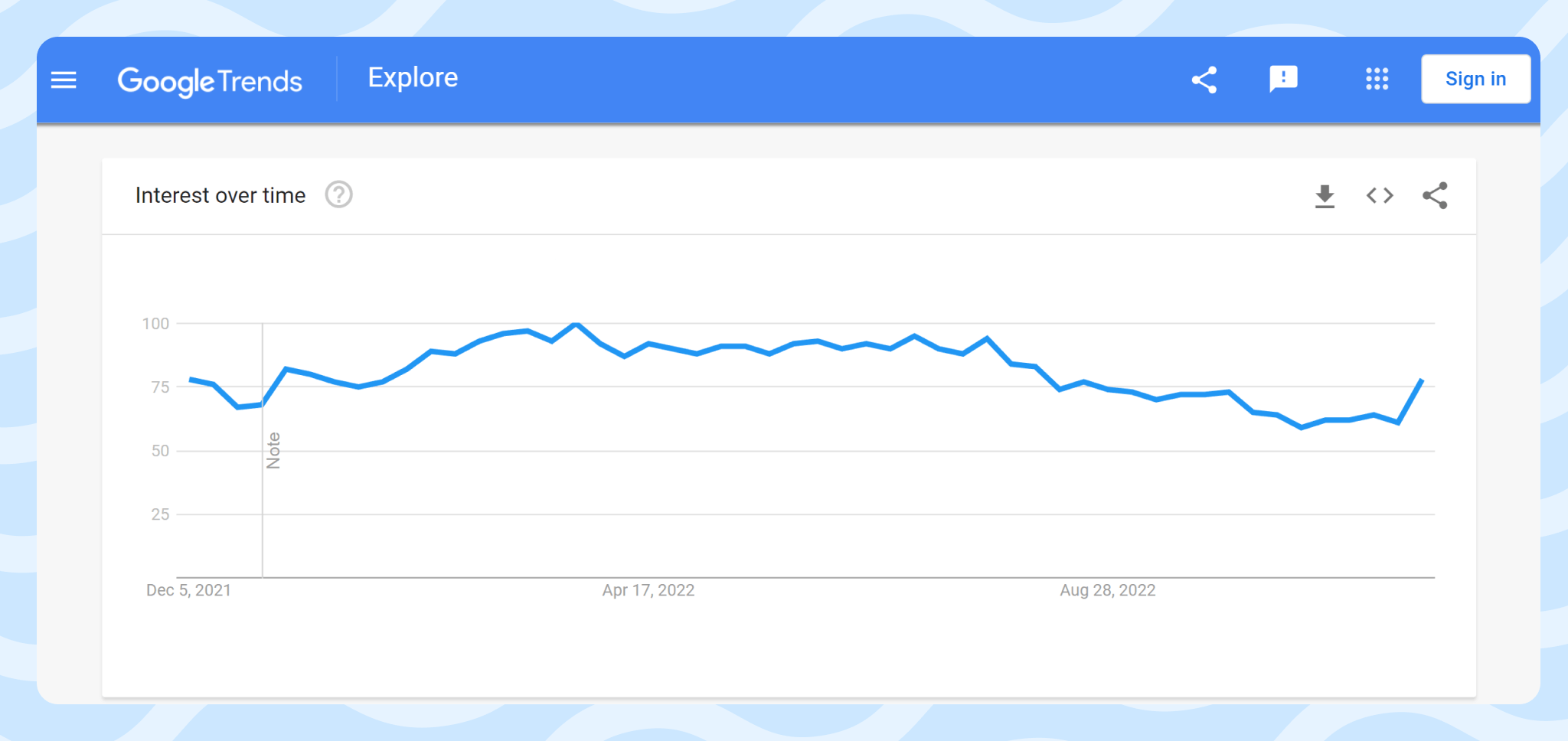
If you can’t share stories about the place you are right now, you can also choose not to travel and create content about your past travels. In addition, you can invite authors to prepare quality content for you.
If you can travel (even on a budget), it will dramatically expand the topics you can write about.
Some bloggers talk about places they have never been and prepare content based on the stories of others. These bloggers mostly approach blogging as a job and are more likely webmasters than bloggers. This approach also allows you to produce a lot of content, but there is a high chance that Google will not give preference to your content and you will not attract much traffic, since Google and real people prefer an expert creating unique content.
How much can I earn from a travel blog?
Having a travel blog does not guarantee that you will earn money. You have to find your audience since traffic on your blog is necessary in order for you to earn via most monetization methods, such as affiliate marketing or contextual ads.
There is no cap on earnings. As mentioned earlier, some bloggers earn five figures per month. To calculate your estimated revenue, you can use the average revenue per 1,000 impressions ($30-50 for US traffic). You can predict your estimated traffic based on the search volume of search queries you are creating content for.
If you have any questions about how to become a travel blogger and start making money on your blog, write your suggestions in the comments and we will be glad to help.


